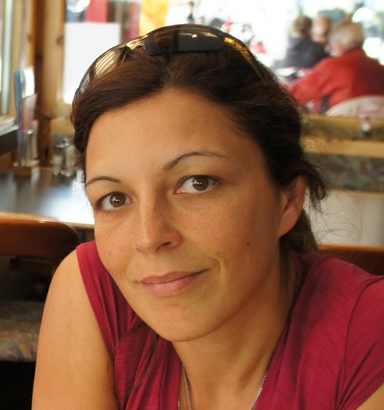|
|
News:
|
2013-2016
|
|
NSF Grant DMS-1313221, The
mathematics of pseudocodewords,
(PI, 2013-2017).
|
|
2012-2015
|
|
NSF CIF-Award on Spatially
Coupled Sparse Codes on Graphs: Theory,
Practice, and Extensions (PI,
2012-2016; collaborative research with EE,
Notre Dame, UCLA, New Mexico).
|
|
2008-2011
|
|
NSF CCF-Award on New
Directions in Graph-Based Code Design
(PI, 2008-2012; collaborative research with
EE, Notre Dame).
|
|
2007-2010
|
|
NSF DMS-Award on Pseudo-Codeword
Analysis and Design of Quasi-Cyclic and
Convolutional Codes (PI, 2007-2011).
|
2014-2017
|
|
Editorial board for the IEEE
Transactions in Information Theory
|
|
| 2013-2014 |
|
Editorial
board for the Advances
in Mathematics of Communications (AMC)
journal.
|
2016
|
|
Constructing
strongly-MDS convolutional codes with
maximum distance profile. D.
Napp and R. Smarandache, Advances in
Mathematics of Communications AMC, Vol.
10, no. 2, pp. 275-290, 2016.
|
| 2014 |
|
Quasi-Cyclic LDPC Codes
Based on Pre-lifted Protographs. D.
G. M. Mitchell, R. Smarandache, and D. J.
Costello, Jr., IEEE Trans. Inform.
Theory, Vol. 60 (10), pp. 5856-5874, 2014. |
| 2014 |
|
Spatially Coupled Sparse
Codes on Graphs - Theory and Practice. D.
J. Costello, Jr., L. Dolecek, T. E. Fuja, J.
Kliewer, D. G. M. Mitchell, and R. Smarandache,
IEEE Communications Magazine, Vol. 52 (7), pp.
168-176, 2014.
|
| 2013 |
|
Diversity
Polynomials for the Analysis of Temporal
Correlations in Wireless Networks. M.
Haenggi and R. Smarandache, IEEE Trans. on
Wireless Comm., Vol. 12 (11), pp. 5940-5951,
2013.
|
Teaching:
EE 30363 Random Phenomena in Electrical Engineering
(Spring 2016)
MATH 10360-06 Calculus B (Spring 2016)
MATH 30310 Undergraduate Coding Theory (Fall
2015)
EE 30363 Random Phenomena in Electrical
Engineering (Spring 2014)
MATH 30310 Undergraduate Coding Theory (Fall
2013)
MATH
10550 Calculus I (Fall 2013)
MATH
87500 Coding Theory (Spring 2013)
EE 80654 Coding Theory (Fall 2012)
MATH 10260 Elements of Calculus II (Spring 2006)
MATH 40210 Basic Combinatorics (Fall 2005)
MATH 10250 Elements of Calculus I (Fall 2005)
Publications
CV
Research Projects:
Dr. Smarandache's research topics are mainly related
to coding
theory.
|
The research projects are within or at the
intersection of these fields:
Coding Theory
Combinatorics
Graph Theory
Network coding, index coding, coding for
storage
|
|
|
|
|
Current
topics/graduate projects and links to
some papers:
Properties of Bethe-permanents of matrices:
approximating permanents of matrices (permanents
are like determinants but the addition is
without the alternating sign) [pdf][pdf]
Interference and the diversity polynomial [pdf]
LDPC codes: algebraic and combinatorial
approaches [pdf] [pdf]
Spatially coupled LDPC codes: design
and decoding issues [pdf] [pdf]
Pseudocodewords, trapping sets and
absorbing sets for LDPC codes:
designing codes with predictable low error floor[pdf]
[pdf]
[pdf]
Convolutional codes with large distance (over
large finite fields): constructions [pdf] [pdf][pdf][pdf] [pdf]
[pdf]
[pdf]
and decoding over the erasure channel[pdf].
Linear programming: pseudocodewords and
connection to compressed sensing [pdf]
Algebraic combinatorics and graph theory:
distance bounds from eigenvalues of the
adjacency matrix [pdf]
|
|
|
Research problems:
The theory of error correcting codes offers a
large number of exciting research problems in
applied mathematics and theoretical
engineering, which makes this area appealing
to both mathematicians who would
like to see their ideas and
research being actually applied and
theoretically minded engineers.
|
What
is coding theory:
The field of coding theory is an applied
mathematical field that makes use of
classical and modern algebraic techniques involving
finite fields, discrete mathematics, group
theory, polynomial algebra, combinatorics,
probability, algebraic geometry, or number
theory (depending on the research
directions) to solve applied problems in
telecommunications.
It deals with the design of
error-correcting
codes, which are sets of vectors of a certain
given length chosen according to some desired
algebraic or probabilistic rules to allow for the
reliable transmission of information across noisy
channels.
Error-correcting codes are an integral component of
all communication systems currently in operation:
- CD, DVD, Blu-ray players and computer hard
drives are protected from errors by Reed-Solomon
codes (these are sets of all polynomials having
roots some consecutive powers of a primitive element
of a given field);
- communication with deep-space missions depends
crucially on LDPC codes (these are kernels of a very
sparse binary matrices), and
- transmission over fiber-optic cables would not
be possible without a number of codes (discussed in
any coding course).
|
